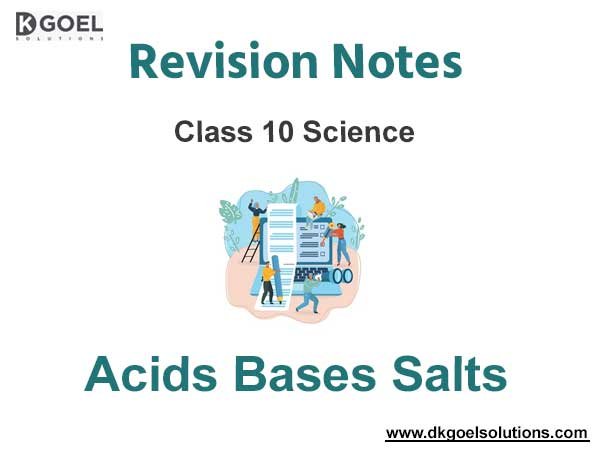Chapter 2 Acids Bases Salts Class 10 Science Notes
Students should read Chapter 2 Acids Bases Salts Class 10 Science Notes provided below. These notes have been prepared based on the latest syllabus and books issued by NCERT, CBSE and KVS. These important revision notes will be really useful for students to understand the important topics given in the chapter Chemical Reactions and Equations in Class 10 Science. We have provided class 10 science notes for all chapters.
Revision Notes Chapter 2 Acids Bases Salts Class 10 Science
Chapter 2 Acids Bases Salts is an important chapter in Class 10 Science. The following notes will help you to understand and easily learn all important points to help you score more marks.
Acids: Substances which turn blue litmus solution red are called acids. Acids are sour in taste
Bases: Substances which change red litmus solution blue are called bases. They are bitter in taste.
Mineral Acids: Acids which are obtained from minerals likesulphates, nitrates, chlorides etc. are called mineral acids, e.g., H2SO4(Sulphuric acid), HNO3(Nitric acid) and HCl (Hydrochloric acid).
Organic Acids: Acids which are obtained from plants and animals are called organic acids.e.g. citric acid, ascorbic acid, tartaric acid, lactic acid, aceticacid.
Hydronium Ions(H3O+): They are formed by reaction of H+ (from acid) and H2O. It is because H+ is unstable.
Strong Acids: Acids which dissociate into ions completely are called strong acids. E.g. H2SO4, HCl
Weak Acids: Acids which do not dissociate into ions completely are called weak acids E.g.Citric acid,acetic acid.
Chemical properties of acids
(i) Acids react with active metals to give salt and hydrogen gas.
(ii) Acids react with metal carbonate and metals hydrogen carbonate to give salt, water and carbon dioxide.
(iii) Acids react with bases to give salt and water. This reaction is called neutralization reaction.
(iv) Acids react with metals oxides to give salt and water.
Chemical properties of Bases
(i) Reaction with Metals: Certain metals such as Zinc, Aluminumand Tin react with alkali solutions on heating and hydrogen gas is evolved
(ii) Reaction with acids: Bases react with acids to form salt and water
Indicators: Indicators are substances which indicate the acidic or basic nature of the solution by their colour change.
Universal Indicator: A universal indicator is a mixture of indicators which shows a gradual but well-marked series of colour changes over a very wide range of change in concentration of H+ ion.
pH scale: A scale for measuring hydrogen ion concentration in a solution.
The pH of a solution is defined as the negative logarithm of hydrogen ion concentration in moles per litre.
pH =-log [H+]
pH =-log [H3O+]
where [H+] or [H3O+] represents concentrations of hydrogen ions in solution.
The pH of a neutral solution is 7
The pH of an acidic solution is < 7
The pH of a basic solution is> 7
Some Important Compounds and their uses

EQUATIONS OF ACIDS,BASES AND SALTS
Acid + Metal → Salt + Hydrogen gas
H2SO4+Zn → ZnSO4+H2
Base+ Metal → Salt + Hydrogen gas
2NaOH + Zn → Na2ZnO2 + H2
(Sodium zincate)
Base + Acid → Salt + Water
NaOH (aq) +HCl (aq) → NaCl (aq) + H2O (l)
Acids give hydronium ions in water
HCl+H2O H3O++ Cl–
Reactions of Important Chemical Compounds
On heating, baking soda liberates CO2
Heat
2NaHCO3 → Na2CO3 + H2O + CO2
Plaster of Paris
On mixing plaster of Paris with water, gypsum is obtained
CaSO4.½ H2O +1 ½ H2O → CaSO4 .2H2O
MIND MAP


